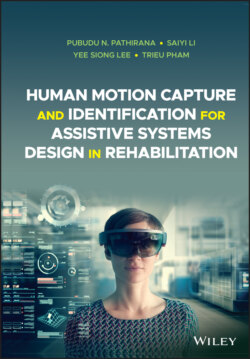Читать книгу Human Motion Capture and Identification for Assistive Systems Design in Rehabilitation - Pubudu N. Pathirana - Страница 12
1.2.2 Neuromuscular disorders
ОглавлениеThe disorders that can be associated with the nervous and muscular systems affect the movements and can sometimes exhibit characteristic movement patterns associated with certain conditions. Neuromuscular disorders affect the nerves that control the voluntary muscles – muscles that can normally be controlled by the individual. Such disorders include motor neurone diseases, neuropathies, muscular dystrophies and neurodegenerative disorders. These disorders can be classified according to the area of the neuromuscular system that is affected.
Table 1.1 Examples of musculoskeletal injuries in joints of the upper extremities. Inj is for injury and ST is for studies about using physical rehabilitation to treat the conditions or stimulate recovery (the same as that in Table 1.2).
| Shoulder | Elbow | Wrist | |
|---|---|---|---|
| Movements | Flexion, extension, abduction, adduction, internal and external rotation [84] | “Flexion and extension at the ulnohumeral and radiocapitellar articulations, while pronation and supination at the proximal radioulnar joint” [56] | Flexion, extension, radial deviation and ulnar deviation [271] |
| Inj1 | Shoulder impingement | Tennis elbow | Carpal tunnel syndrome |
| Description | It “occurs against the anterior edge and undersurface of the anterior third of the acromion, the coracoacromial ligament, and, at times, the acromioclavicular joint” [255] and deemed as one of the factors that lead to shoulder disability [254]. | Although it is not perfectly understood, it negatively influences “the attachment of the extensors of the forearm at the lateral side of the elbow”, thereby leading to pain [365]. | It usually is caused by the pressure on the median nerve on a wrist and leads to various conditions, such as pain, paraesthesiae, hypoaesthesia and so on [287]. |
| ST | [238] | [366] | [251] |
| Inj2 | Adhesive capsulitis | Scaphoid | |
| Description | The general cause leading to this condition is described as “progressive fibrosis and ultimate contracture of the glenohumeral joint capsule” [258]. | It is usually caused by a hyperextended and radially deviated wrist and seen in patients aged between 15 and 40 [167]. | |
| ST | [343] | [299] |
